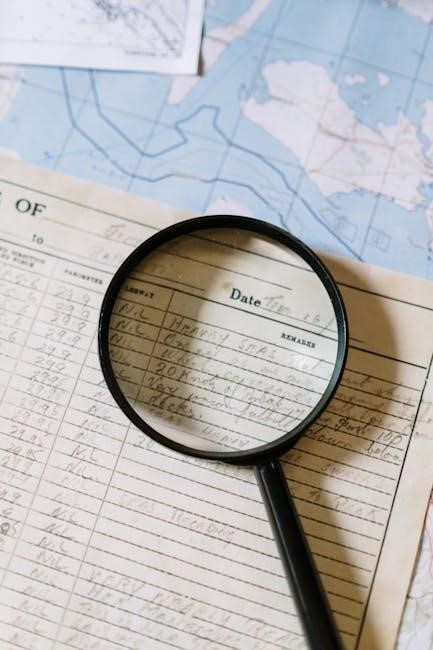Historical writing explores the past through evidence and perspectives, offering insights into events, cultures, and societies. It requires critical analysis and clear narrative to engage readers effectively.
The Importance of Context in Historical Writing
Context is essential in historical writing as it provides the backdrop for understanding events, ideas, and cultures. It involves examining social, political, and cultural factors that shaped historical moments. Without context, events appear isolated and lose their deeper meaning. Historians must consider multiple perspectives and sources to build a comprehensive narrative, ensuring accuracy and relevance. Context also helps readers connect historical events to broader themes, making the past more accessible and relatable. Effective historical writing demands a careful balance of detail and context to illuminate the complexities of bygone eras.
Understanding Historical Perspectives
Understanding historical perspectives involves analyzing how individuals and groups viewed events in their time. These viewpoints are shaped by cultural, social, and political factors. Historians must identify biases and consider diverse sources to present a balanced narrative. By examining primary and secondary sources, writers can uncover varying interpretations of the past. Recognizing these perspectives enhances the depth and accuracy of historical accounts, allowing readers to grasp the complexities of past societies and their ideologies. This approach fosters a more nuanced and inclusive understanding of history.

Developing a Thesis Statement
A thesis statement clearly outlines your essay’s purpose, guiding the argument and ensuring focus. It should be concise, addressing the historical context and perspectives effectively.
Identifying a Focused Research Question
A focused research question is the foundation of historical writing, guiding your investigation and keeping it manageable. Start by brainstorming broad topics, then refine them into specific inquiries. Use keywords to narrow your scope and ensure relevance. Techniques like advanced search tools can help pinpoint sources. A well-crafted question should be clear, concise, and open to exploration, avoiding overly broad or vague queries. This step ensures your research remains organized and aligned with your thesis, leading to a coherent and impactful historical analysis.
Structuring Your Argument Clearly
Structuring your argument clearly is essential for effective historical writing. Begin with a strong thesis statement that outlines your position. Use chronological or thematic organization to present evidence logically. Each paragraph should focus on a single idea, supported by primary and secondary sources. Ensure smooth transitions between sections to maintain flow. Address counterarguments to strengthen your position. Conclude by summarizing key points and reinforcing your thesis. Clarity and coherence are crucial for conveying your analysis persuasively and engaging your readers throughout the essay.
Conducting Effective Research
Effective research involves refining search queries, using advanced tools, and evaluating sources critically to gather relevant, credible information efficiently, ensuring a solid foundation for historical writing.
Locating Primary Sources
Primary sources, such as letters, photographs, and official documents, provide direct evidence of historical events. They can be found in archives, libraries, and online databases. Researchers often use specific search techniques, like refining queries or using advanced tools, to locate these materials. Evaluating the credibility and relevance of primary sources is crucial for accurate historical interpretation. Accessing these materials may require visiting physical archives or utilizing digital platforms that host historical records. Effective use of primary sources strengthens historical writing by offering firsthand insights and authentic perspectives.
Evaluating Secondary Sources
Secondary sources, such as books, articles, and documentaries, interpret historical events through analysis and synthesis. When evaluating them, consider the author’s credibility, publication date, and potential biases. Assess whether the source is scholarly or popular, as academic works often provide deeper insights. Look for evidence of thorough research and balanced perspectives. Secondary sources can offer valuable interpretations but should be cross-referenced with primary sources to ensure accuracy. Critical evaluation of these sources strengthens historical writing by providing context and supporting arguments with expert analysis.
Using Archival Materials
Archival materials, such as letters, photographs, and manuscripts, provide firsthand insights into historical events. Researchers often visit archives to access these primary sources, which can be physical or digital. Organize your approach by systematically reviewing materials, taking detailed notes, and cross-referencing with other sources. Contextualize findings within broader historical narratives to enhance credibility. Proper citation and respect for copyright or restrictions are essential. Archival materials offer unique perspectives, enriching historical writing with authentic voices and untold stories, while requiring careful handling to maintain academic integrity.

Interpreting Historical Evidence
Interpreting historical evidence involves analyzing sources to uncover meanings, identify biases, and draw conclusions. This process requires critical thinking and contextual understanding to build a coherent narrative;
Analyzing Primary Sources
Primary sources, such as documents, images, and artifacts, offer direct insights into historical events. When analyzing them, consider the author’s intent, context, and purpose. Examine language, tone, and biases to interpret meanings. Compare multiple sources to identify patterns or contradictions. Evaluate the credibility and reliability of the source, considering its origin and audience. Use these analyses to construct a well-supported historical narrative, ensuring a nuanced understanding of the past. This step is crucial for building a robust and accurate historical argument.
Assessing Bias in Sources
Recognizing bias in historical sources is essential for objective analysis. Bias can distort interpretations, so identifying it helps maintain accuracy. Consider the author’s background, motivations, and intended audience. Examine language and tone for emotional or partisan leanings. Compare multiple sources to detect inconsistencies or one-sided perspectives. Be aware of cultural, social, or political influences that may shape the narrative. By critically evaluating bias, historians can present balanced interpretations and avoid perpetuating skewed viewpoints in their writing.
Organizing Your Essay
Organize your essay with a clear structure: introduction, body paragraphs, and conclusion. Use logical flow and coherence to connect ideas, ensuring each section transitions smoothly to the next.
A well-crafted introduction sets the tone for your essay. Begin with a compelling hook to engage readers, such as a thought-provoking question or a relevant historical anecdote. Provide essential context to situate your topic within its historical timeframe and significance. Clearly state your thesis statement, outlining the central argument or focus of your essay. Conclude the introduction with a brief roadmap of the key points or themes that will be explored in the body paragraphs, ensuring a logical flow of ideas.
Outlining the Body Paragraphs
Each body paragraph should focus on a single, clear idea that supports your thesis. Start with a topic sentence that outlines the main point, followed by evidence from primary sources to reinforce your argument. Provide context to help readers understand the significance of the evidence. Use analysis to explain how the evidence supports your claim, ensuring a logical flow between paragraphs. Conclude each paragraph with a sentence that summarizes the key point and transitions to the next idea, maintaining coherence throughout the essay.
Concluding Your Argument
The conclusion should summarize your main points without introducing new evidence. Restate your thesis clearly and ensure it aligns with the arguments presented. Highlight the significance of your findings and their relevance to the broader historical context. Avoid overcomplicating the ending; instead, provide a concise and impactful summary. Use this section to reflect on the implications of your argument and leave the reader with a lasting impression of your analysis. Clarity and brevity are key to an effective conclusion.

Writing Style in Historical Essays
Historical essays require clarity, precision, and an objective tone. Use formal language, avoid jargon, and ensure coherence to effectively convey your analysis and engage readers.
Maintaining Clarity and Precision
Maintaining clarity and precision is crucial in historical writing. Use clear, concise language to convey ideas effectively. Avoid overly complex sentences or vague terms. Ensure each argument is supported by evidence. Precision involves accurately interpreting sources and presenting facts without distortion. Clarity helps readers follow your reasoning, making your argument more compelling. Edit your work to eliminate unnecessary words and ensure each sentence contributes to the overall narrative. This approach strengthens your analysis and enhances readability.
Adopting an Objective Tone
An objective tone is essential in historical writing to establish credibility. Avoid biased language or personal opinions. Present facts impartially, allowing evidence to guide your narrative. Use neutral phrasing to describe events and perspectives, ensuring balanced representation of differing viewpoints. This approach fosters trust in your analysis and demonstrates a commitment to scholarly integrity. Maintaining objectivity enhances the persuasiveness of your argument and ensures your work is respected as a reliable historical account.

Integrating Sources
Effectively integrating sources strengthens your historical narrative by supporting claims with evidence. Use primary sources for direct insights and secondary sources for broader context and analysis.
Incorporating Primary Sources
Primary sources are original materials from the time period being studied, such as letters, diaries, photographs, or official documents. They provide direct evidence and unique insights into historical events. When incorporating primary sources, ensure they are relevant to your argument and properly contextualized. Analyze the source’s purpose, audience, and potential biases. Use quotes or descriptions sparingly, always explaining their significance. This approach strengthens your narrative and demonstrates a deep understanding of the historical context. Proper citation is essential to maintain academic integrity.
Using Secondary Sources Effectively
Secondary sources, such as scholarly articles and history books, offer interpretations and analyses of historical events. They are essential for understanding various perspectives and building context. When using secondary sources, evaluate the author’s credibility and arguments. Use them to support your thesis, provide background information, or address counterarguments. Avoid over-reliance on a single source; instead, synthesize multiple perspectives to create a balanced and comprehensive narrative. This approach enhances the depth and credibility of your historical writing.

Analyzing Historical Events
Historical events reveal insights into societal dynamics, cultural shifts, and human experiences. Analyzing them involves examining causes, effects, and context to understand their significance and impact over time.
Examining Cause and Effect
Examining cause and effect in historical events involves identifying relationships between actions, decisions, and their outcomes. Historians analyze how events trigger subsequent occurrences, considering both direct and indirect impacts. This process requires evaluating evidence, context, and multiple perspectives to understand motivations and consequences. By tracing causal chains, writers can explain how historical developments shaped societies, cultures, or policies. This approach helps readers grasp the complexity and interconnectedness of past events, illuminating patterns and lessons for the present.
Comparative Historical Analysis
Comparative historical analysis involves examining two or more historical events, societies, or periods to identify similarities, differences, and patterns. This method helps historians uncover underlying causes, shared themes, or divergent outcomes. By contrasting contexts, practices, or ideologies, writers gain deeper insights into the complexities of human experiences. Comparative analysis also highlights how different societies responded to similar challenges, offering a broader understanding of historical processes and their relevance to contemporary issues.

Addressing Counterarguments
Addressing counterarguments strengthens your historical argument by acknowledging opposing views and refuting them with evidence. This shows thorough research and a balanced perspective, enhancing credibility.
Strengthening Your Argument
Addressing counterarguments refines your historical argument by considering opposing viewpoints. Use specific search commands like site: to find credible sources, ensuring your argument is well-supported. Advanced search functions help pinpoint precise information, enhancing the validity of your claims. By acknowledging and refuting counterarguments, you demonstrate a deeper understanding of the topic, making your argument more convincing and robust. This approach ensures your historical writing is balanced, evidence-based, and persuasive, leaving readers with a clear and compelling narrative.

Revising and Editing
Refine your argument by reviewing and polishing your writing. Ensure coherence and clarity, addressing any gaps or inconsistencies. Use advanced search tools to verify facts and enhance precision, strengthening your historical narrative with accurate and well-supported details.
Refining Your Argument
Refining your argument involves reviewing and strengthening your claims to ensure clarity and coherence. This step requires analyzing gaps in your reasoning and verifying that evidence fully supports your conclusions. By revisiting your thesis, you can align your arguments more precisely with the historical context and sources. Additionally, refining your argument may involve incorporating new insights or reorganizing your points for greater impact. Clarity in expression is key to conveying your ideas effectively.
Use specific examples from your research to bolster weak points and address potential counterarguments. This process not only sharpens your perspective but also enhances the persuasiveness of your historical narrative. Remember, refining your argument is about precision and depth, ensuring your analysis resonates with readers and stands up to scrutiny. Regularly revisiting and polishing your work is essential for producing a compelling and well-supported historical account.
Ensuring Coherence
Coherence in historical writing involves creating a logical flow of ideas that connects evidence, analysis, and argument. Use transitional phrases to guide readers through your narrative, ensuring each paragraph builds on the previous one. Clear topic sentences and consistent structure help maintain clarity and focus.
Revise your work to eliminate disjointed sections and ensure smooth progression. Check that each idea aligns with your thesis and supports the overall narrative. Coherence strengthens the readability and persuasiveness of your historical account, making it easier for readers to follow and engage with your argument.
Proper Citation Practices
Proper citation practices ensure accuracy, credibility, and acknowledge sources, avoiding plagiarism. They require precise formatting and adherence to academic standards, crucial in historical writing.
Using Chicago Manual of Style
The Chicago Manual of Style offers detailed guidelines for formatting academic papers, including footnotes, endnotes, and bibliographies. It provides clarity and consistency in historical writing, ensuring sources are properly acknowledged. By following Chicago’s rules, writers maintain professionalism and academic integrity, which are essential for credible historical research. Proper citation not only respects original authors but also enhances the reliability of the work, making it a cornerstone of scholarly writing in history.
Avoiding Plagiarism
Avoiding plagiarism is crucial in historical writing to maintain academic integrity. Proper citation of sources ensures originality and gives credit to authors. Use paraphrasing and direct quotes with citations to avoid copying others’ work. Tools like plagiarism checkers can help verify uniqueness. Always cite sources, whether primary or secondary, to prevent intellectual theft; This practice upholds ethical standards and strengthens the credibility of your work in historical scholarship.

